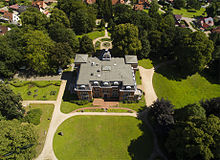Etelsen Castle
The Etelsen Castle is in the long Wedeler village Etelsen at Verden in Lower Saxony in neo -built architecture castle. In the years 1885–1887 it was built by the von Heimbruch brothers to replace an older manor house. Today it belongs to the district.
history
In the 1860s the Etelsen estate belonged to the former Hanoverian Landdrosten and Minister Johann Caspar von der Wisch (1785–1856), who shared this property with his brother, Hieronimus von der Wisch (1788–1873) in 1858, including the Koppel estate, Embsen and Ruschbaden had combined to form a Fideikommiss . In the year Hieronimus died, a neo-Gothic mausoleum was built in the park in which the brothers and later owners were buried. After the death of von der Wischs, Etelsen fell to the brothers Carl Johann Christian (1820–1895) and Gottlieb Ernst August von Heimbruch (1822–1892), owners of the Varste and Polle estates , and they too were high-ranking Hanoverian military and diplomats. From 1885 to 1887 they had the palace built in its present form by the architect Karl Hantelmann from Hanover. They too died childless, so that their inheritance fell to the Reventlow family .
Count Christian zu Reventlow moved into the castle on October 10, 1896 and lived there with his family until his death in 1922. In 1922 he was the last to be buried in the mausoleum. Heir to the entire estate was his eldest son, Lehnsgraf and royal Hofjägermeister Rudolph zu Reventlow (1879-1945), who sold, mostly on trips in the following years, all lands, leaving only the empty castle with the approximately 11-hectare castle park left stayed. The palace and park were sold to the North Sea SA group in 1937 and served as an SA group school until the end of the war.
After the Second World War , the castle was initially used as a British military hospital . From 1948 to 1953 it was used as a hospital; after that it stood empty for six years. At the instigation of a Bremen merchant, an animal park with a castle restaurant was set up on the castle grounds in 1959 . The mausoleum served as accommodation for the lions . After a few years of good visits, enthusiasm for the zoo decreased noticeably, so that this unusual form of use for a castle could no longer be continued. For a short time the castle then housed a casino . The palace and parks deteriorated more and more.
In 1978 the castle was placed under monument protection.
In 1979, citizens founded the association “Förderkreis Schloss Etelsen” with the aim of keeping the castle in good condition and the park open to the public. After these goals for the building had been achieved, the "Schlossparkverein Etelsen" was founded in 1981 with the aim of taking over, repairing and maintaining the park.
Since around 1983, now owned by the Verden district and extensively restored, the castle has been used by the Lower Saxony Business Education Center (BNW). In addition, exhibitions and concerts take place in the castle. Civil weddings have also been held in the castle since 2004 .
The Etelser Schlosspark is freely accessible, from there you have a wide view of the Wesermarsch.
architecture
Etelsen Castle was laid out as a rectangle of 22 mx 35 m, with two full floors, a raised basement and a mansard floor . The brick masonry is framed by stone structures . The architecture mixes (like Hantelmann's other noteworthy building, the Dragon Slayer House in Hanover), as a typical building of historicism in an eclectic manner, different stylistic elements. The main facade, the center of which is highlighted by the loggia and dome, is based on French Renaissance models. The garden front contains more baroque elements.
- mausoleum
The 15 m high grave building, built in neo-Gothic shapes according to plans by the important Hanoverian architect Conrad Wilhelm Hase , with its pointed tower roofs is reminiscent of a gate or a chapel. Originally it was covered with glazed roof tiles, which were replaced by slate panels around 1920. The medallion above the entrance shows the coat of arms of those von der Wisch . As early as 1937, the coffins had been transferred to the family grave in the old Daverden cemetery. The protection as a monument in 1984 was justified with the following words: "The consistent design as a central building , which is to be seen as a reminiscence of Byzantine domed buildings, is also one of the great rarities in Lower Saxony."
- park
The garden artist Friedrich Kreiß from Braunschweig redesigned the 10 hectare site in the style of a landscape garden around 1899 .
Web links
- Schlossparkverein Etelsen eV
- Website of the current user of Etelsen Castle as the conference venue
- Description of the palace park at the Lower Saxony Society for the Preservation of Historical Gardens
supporting documents
- ↑ Johann von der Wisch biography with further literature.
- ↑ Heimbruch family , accessed on January 7, 2016.
- ↑ Information on www.etelsen.de , accessed on August 14, 2015.
- ^ Georg Dehio: Handbuch der deutschen Kunstdenkmäler, Bremen, Lower Saxony, Munich 1992, p. 460.
- ↑ Marius Merle: Underestimated Treasure of Architecture , in: Weser-Kurier of January 29, 2017, p. 33.
Coordinates: 52 ° 59 ′ 43 " N , 9 ° 6 ′ 45" E




